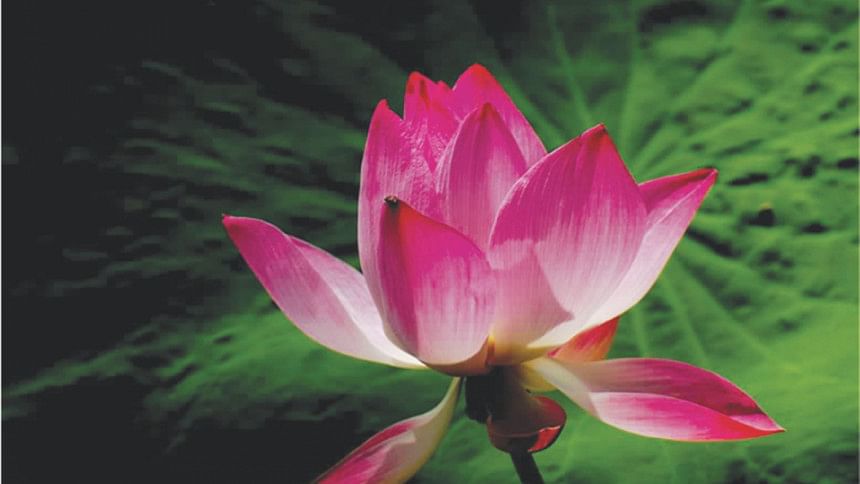Loving and Living With Plants

The legend behind the Lotus
The Lotus - the water lily symbolises beauty, majesty, grace, fertility, wealth, richness, knowledge and serenity. There are several types and colours of this water lily. Shapla is honoured as our national flower and Padma – the lotus type is for auspicious purpose, the flower of God and Goddesses.
In the past few days we have seen from media reports how this single flower added value to the nature of Bangladesh, especially the country side, the hoar and bills (marshy wide water bodies). Whoever experienced the scene knows that it is unforgettable and a memory to cherish forever! Lotus not only pleases our eyes, but is very much essential in our religious lives. For Hindus and Buddhists, this is the symbol of purity and a means of offering.
Very recently we had three back to back religious festivals; Durga Puja followed by Lakhmi Puja and the Buddha Purnima. We know, lotus is special to the goddesses of Lakhi, Duga, Swarshwati and also to Lord Shiva. Lakhmi, the Goddess of wealth, holds lotus in her two hands! In Buddhism, lotus is auspicious; it is the flower that symbolises 'fortune, rising and blooming above the murk to achieve enlightment, purity – spirit of the mind and body and faith and fullness'. It is also treated as the symbol of beauty, prosperity and fertility. This sacred flower represents eternity, divinity and the journey of life, ever renewing youthfulness. The colour of lotus also speaks. White goes for purity, golden for achievements, red for compassion and love, blue refers to common sense, pink tells the history and legends of Buddha and also represents self-awareness and purple is for purity. The stages of its growth also depict the journey of human lives. Lotus grows in mud and that tells us life evolves from soil and rotten contents, it has fragile roots, it has sufferings – with resilience finally it reaches the fullest beauty and purpose. The Hindu holy book Gita says ' human is adjured to be like the lotus; they should work without attachment, dedicating their actions to God, untouched by sin like water on a lotus leaf, like a beautiful flower standing high above the mud and water'. In Egyptian mythology, the Lotus is associated with the sun, because it bloomed by day and closed by night and was even believed to have given birth to the sun! Besides religion, Lotus also is a symbol for various forms of dances and Yoga (PadmaAshona) posture. Engraved motif of lotus is seen in all the walls of mandir and has great value in architectural design. Lotus is treated as a medicinal plant in Indian Ayurvedic medicine mainly used to treat indigestion and also used as food item.
In Bengali literature, Lotus is the symbol of feminine beauty– the eyes of the lady of love is described as –Padmalochona!
Lotus is easy to grow in our urban set ups - It is in y/our reach. Just visit a good nursery. The nursery staff will help you out with all the learning and facilities required - with a not so expensive price.
Quick Tips! Select the right container. You can grow lotus in plastic and ceramic or clay containers though, but better to put in used bath tubs or pre –formed ponds in landscape (see the images). The right size container will depend on the type of lotus you chose. Bowl lotuses are very small and can fit comfortably inside a 2-gallon (7.57-liter) container, but a large lotus may need a 50-gallon (189.27-liter) container. Aquatic containers for lotus are available (not in our country, but chari - our native container also works) Most dwarf lotus are capable of getting 3' to 4' tall. They can tolerate smaller containers, but will perform better in larger containers. Make sure that your container does not have holes. Fill your container with dirt; 60 percent clay and 40 percent sands (a mix of clay and construction site sand is ideal). Dense soils with lot of rotten leaf - mash also work sufficiently well. Leave about 1 to 4 inches (2.54 to 10.16 cm) free-empty space in between the top of the soil and the rim of the pot. Lotus prefers full sunlight - at least few hours a day is necessary for its healthy growth. Lotus will make floating leaves first, then standing leaves. It is best to begin fertilising when the lotus is starting to make standing leaves. A pinch or very small portion of urea will do. Lotus is adaptable to different water chemistries. During pruning or trimming time, never cut flower or leaf stems below the water level, as roots and tubers use stems (even dead ones) to provide oxygen to the roots. Be aware about pests like white fly and spider mites.
Lotus grows well with fishes – try with goldfish!
Please feel free to send me email to share your thoughts, feedback, and photos of your garden, or to tell your story; or ask a question on the garden issue. Email: [email protected]

 For all latest news, follow The Daily Star's Google News channel.
For all latest news, follow The Daily Star's Google News channel. 



Comments